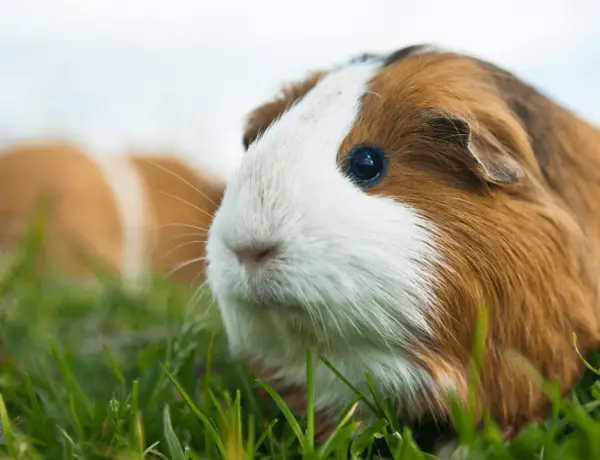Introduction
Understanding the temperature preferences of guinea pigs is crucial for their well-being and comfort. Guinea pigs are small and gentle rodents with specific temperature requirements to thrive in their environments. This exploration delves into the temperature range that guinea pigs prefer and the essential factors to consider for their care. From their native South American habitat to your cozy pet space, guinea pigs’ temperature needs are a vital aspect of their overall health and happiness. Join us as we discover the ideal temperature range that keeps these adorable pets content and thriving.
Guinea pigs, often known as cavies, are native to the Andes region of South America, where they are accustomed to a relatively mild and stable climate. Understanding their temperature preferences and how to provide them with the right environment is essential for responsible guinea pig ownership. In this exploration, we will delve deeper into the specific temperature range that guinea pigs thrive in, the signs of discomfort in extreme temperatures, and the steps you can take to ensure your guinea pig’s well-being regardless of the season.
Guinea pigs, those delightful and gentle rodents, come from the highlands of South America, where temperatures are relatively mild and stable. To keep your guinea pigs content and healthy, it’s essential to replicate their preferred temperature range in their living environment. In this exploration, we will delve further into the specific temperature conditions that guinea pigs thrive in, understand how they react to extreme temperatures, and explore the measures you can take to ensure your furry companions remain comfortable year-round. Whether you’re a devoted guinea pig owner or considering bringing these delightful pets into your life, understanding their temperature preferences is a fundamental aspect of responsible care.

Do guinea pigs like hot or cold temperatures?
Guinea pigs are comfortable only in the narrow temperature range from 65°F to 75°F (18°C to 23°C). They also prefer a low relative humidity (below 50%). When exposed to temperatures above 85°F (29°C), they may develop heat stroke.
Guinea pigs have a preference for moderate temperatures. They are sensitive to extreme heat and cold, and both can be detrimental to their health.
Hot Temperatures: Guinea pigs are highly susceptible to heat stress and heatstroke. They do not have efficient cooling mechanisms like sweating, so they rely on panting and seeking shade to regulate their body temperature. In hot weather, guinea pigs can quickly become overheated, leading to distress and potential health issues.
Cold Temperatures: Guinea pigs are also sensitive to cold temperatures, as they cannot tolerate freezing conditions. Cold weather can lead to hypothermia, causing shivering, lethargy, and even death if left unaddressed. It’s essential to protect them from drafts and ensure they have adequate bedding to stay warm.
Ideal Temperature Range:Guinea pigs thrive in a temperature range of 65°F to 75°F (18°C to 24°C). This range replicates their native South American habitat and keeps them comfortable. Maintaining this temperature range is crucial for their well-being.
What temperature do guinea pigs like Celsius?
Guinea Pigs like temperatures of between 18 to 23 degrees Celsius. If it drops below 15 degrees your piggy can get chilled. If it gets hotter than 26 degrees, your piggy could get heatstroke. When a Guinea Pig is cold the blood flow to the skin reduces to conserve heat.
Guinea pigs, those charming and gentle rodents, thrive in a specific temperature range to ensure their well-being and comfort. While guinea pig owners often use Fahrenheit for temperature measurement, it’s equally important to understand this range in Celsius, especially for those in regions that use the metric system.
Ideal Temperature Range: Guinea pigs prefer temperatures between 18°C to 24°C (65°F to 75°F). This range replicates the moderate climate of their native South American habitats. Within this temperature range, guinea pigs are most content and healthy.
Celsius Conversion: To provide the ideal environment for your guinea pigs in Celsius, maintain temperatures between approximately 18°C to 24°C. Using a thermometer in their living space allows you to monitor and adjust the temperature to keep it within this range.
Extremes to Avoid: Guinea pigs are sensitive to temperature extremes. Avoid exposing them to temperatures below 10°C (50°F) or above 32°C (90°F) as they can lead to discomfort, stress, and even health issues.
How do I know if my guinea pig is cold?
You can tell if your guinea pig is suffering from the cold if they are shivering, sleeping longer or being more lethargic than normal, less interested in food & drink, and they have cold feet, ears, and a cold nose.
Guinea pigs are sensitive to cold temperatures, and it’s essential to watch for signs of discomfort or distress. Here are some indicators that your guinea pig might be feeling cold:
Shivering: Just like humans, guinea pigs may shiver when they are cold. If you notice your guinea pig trembling, it’s a clear sign that they are feeling chilly.
Curling Up: When guinea pigs are cold, they may curl up into a tighter ball to conserve body heat. They might huddle with their cage mates if they have companions.
Reduced Activity: Cold temperatures can make guinea pigs sluggish and less active. If your usually energetic piggy becomes lethargic, it could be due to the cold.
Hiding: Guinea pigs may seek shelter or hide in their bedding to escape the cold. They might burrow into their hideaways more frequently when they are cold.
Cold Ears or Paws: Feel your guinea pig’s ears and paws. If they feel cold to the touch, it’s a sign that their body temperature has dropped.
Loss of Appetite: Extremely cold conditions can cause guinea pigs to lose their appetite.
What is the normal temperature for a guinea pig?
The normal body temperature of guinea pigs is 99-103 degrees Fahrenheit. The lifespan of a guinea pig is five to six years. Males are larger than females and usually weigh 900-1200 grams whereas the females usually weigh 700-900 grams.
Guinea pigs, those charming and sociable rodents, have a preferred temperature range that ensures their well-being and comfort. Understanding the normal temperature range for guinea pigs is essential for responsible pet ownership:
Ideal Range: Guinea pigs thrive in temperatures between 18°C to 24°C (65°F to 75°F). This moderate range replicates their native South American habitat and keeps them content and healthy.
Monitoring: To ensure your guinea pig’s well-being, use a thermometer in their living space to regularly monitor the temperature. This allows you to make necessary adjustments to maintain the ideal range.
Extreme Temperatures: Guinea pigs are sensitive to temperature extremes. Avoid exposing them to temperatures below 10°C (50°F) or above 32°C (90°F), as this can lead to discomfort, stress, and health issues.
Seasonal Adjustments: During extreme weather conditions, such as hot summers or cold winters, take extra precautions to maintain a suitable environment for your guinea pig. This may involve providing shade and fans in the summer and additional insulation in the winter.
Do guinea pigs get cold at night?
Some rodents, like ground squirrels or Eastern chipmunks, hibernate when the weather turns cold, but guinea pigs don’t. Instead, guinea pigs are most comfortable in air temperatures of about 65°F to 75°F. Anything below about 60°F is probably too cold for your pig.
Guinea pigs, those adorable and gentle rodents, can indeed get cold at night, just like humans. Their sensitivity to temperature changes makes it essential to provide suitable nighttime conditions for their well-being. Here are some key considerations:
Temperature Drop: Nighttime temperatures often drop, and guinea pigs are sensitive to cold. If the ambient temperature falls below their preferred range of 18°C to 24°C (65°F to 75°F), they can become chilly.
Indoor Housing: If your guinea pigs are kept indoors, ensure that their living space is well-insulated and free from drafts. Providing adequate bedding and sheltered hideaways can help keep them warm.
Outdoor Housing: For guinea pigs kept outdoors, it’s crucial to provide an insulated and waterproof hutch or enclosure. Consider additional bedding and heating options during colder nights.
Monitoring:Regularly monitor the temperature in your guinea pigs’ living area, especially at night. Use a thermometer to ensure that it remains within their preferred range.
Bedding:Choosing suitable bedding materials, such as hay or fleece liners, can help keep guinea pigs warm and comfortable.
Do guinea pigs like hot weather?
Guinea pigs are very sensitive to both heat and cold. Keep them in temperatures between 60 and 85 °F to avoid putting their health at risk.
Guinea pigs, those lovable and social rodents, do not particularly enjoy hot weather. They have a preference for moderate temperatures and are highly sensitive to extreme heat. Here are some important points to consider about guinea pigs in hot weather:
Heat Stress: Guinea pigs are prone to heat stress and heat stroke when exposed to high temperatures. They lack efficient cooling mechanisms like sweating and rely on painting to regulate their body temperature.
Discomfort: Hot weather can cause discomfort and distress for guinea pigs. They may become lethargic, lose their appetite, and show signs of distress.
Dehydration: Guinea pigs can become dehydrated quickly in hot weather, increasing the risk of health problems.
Shade and Water: Providing ample shade and access to fresh, cool water is essential during hot weather. Consider placing their enclosure in a shaded area or using fans to help them stay cool.
Signs of Overheating: Watch for signs of overheating, including heavy panting, drooling, and weakness. If you notice these symptoms, move your guinea pigs to a cooler environment immediately.
Do guinea pigs get cold easily?
As they are low to the ground, they’ll get cold easily. Your guinea pigs still need to exercise, so consider making space for their run in an unused garage or shed. Cold guinea pigs need more calories to stay warm so give them lots of good quality hay to nibble on.
Yes, guinea pigs are susceptible to getting cold easily due to their small size and lack of natural insulation. These gentle rodents come from the Andes Mountains in South America, where temperatures are relatively mild. As a result, they are not well-equipped to handle extreme cold.
Factors Contributing to Their Susceptibility to Cold
Small Size: Guinea pigs are small creatures, which means they have a higher surface area-to-volume ratio. This makes them more prone to losing body heat.
Thin Fur: While they have fur, it’s not as thick or insulating as that of some other animals. Their fur is designed more for protection than for warmth.
Inefficient Thermoregulation: Guinea pigs cannot shiver to generate heat like some animals can, and they don’t have the ability to hibernate to conserve energy in the cold.
Lack of Body Fat: Guinea pigs have minimal body fat reserves, which further reduces their ability to stay warm in cold conditions.
Where is the best place to put a guinea pig cage?
A family room or living room works well, but make sure your pigs have a place to retreat if they need some quiet time. Noise: Guinea pigs have very sensitive hearing and their cages should not be placed next to stereos, televisions or other loud noises.
Choosing the right location for your guinea pig’s cage is crucial for their well-being and happiness. Here are some important considerations:
Indoors vs. Outdoors: Guinea pigs are generally best kept indoors, where you can control the environment and protect them from extreme temperatures, predators, and other outdoor hazards.
Avoid Drafts: Place the cage away from drafts and direct airflow, as guinea pigs are sensitive to drafts and can easily become chilled.
Stable Temperature: Ensure the area maintains a stable temperature within the guinea pig’s preferred range of 18°C to 24°C (65°F to 75°F). Avoid placing the cage near radiators, heaters, or air conditioning vents.
Natural Light:Guinea pigs benefit from exposure to natural light. Position the cage in an area with access to natural daylight, but avoid direct sunlight to prevent overheating.
Quiet and Social: Guinea pigs are social animals, so place their cage in a quiet and easily accessible area of your home where they can interact with family members.
Safety:Keep the cage out of reach of other pets, such as dogs and cats, to prevent potential stress or harm to your guinea pigs.
Easy Maintenance:Consider the convenience of cleaning and maintaining the cage when choosing its location.

Conclusion
Guinea pigs thrive in a moderate temperature range that mimics their native South American habitat. They are most comfortable and healthy when kept in an environment with temperatures between 65°F to 75°F (18°C to 24°C). This temperature range ensures that they are neither too cold nor too hot, allowing them to maintain their well-being and overall health.
Maintaining the appropriate temperature is essential for guinea pigs because they are sensitive to extreme heat or cold. High temperatures can lead to heat stress and heatstroke, while low temperatures can result in hypothermia. To ensure the comfort and safety of guinea pigs, it’s crucial to provide proper housing, bedding, and insulation, especially during extreme weather conditions.
Additionally, monitoring their environment and keeping them indoors during excessively hot or cold weather can help protect them from temperature-related health issues. Guinea pig owners should always prioritize the well-being of their pets by providing a comfortable and consistent temperature range, which plays a significant role in their overall happiness and longevity.





No Comments